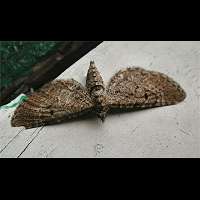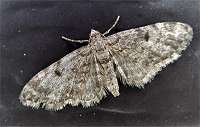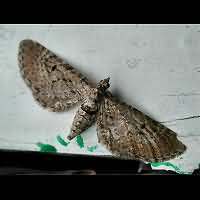Dwarf Pug (Eupithecia tantillaria)
The Dwarf Pug is quite easily identified as such. Especially because of its size: it is one of the smaller pugs around, reaching a wingspan of some 16 to 19 mm only. Compared to other pugs the Dwarf Pug is more brown than grey. Usually also the body gives it away. Just below the thorax is a rather white spot followed by a darkbrownish band. The spot on the forewing is an elonged cirkle and on the hind wing is a clear but small spot. The Oak-tree Pug is similar, but is more boldly marked and often appears to lack the dot on the forewing for it is part of a dark band. The Cloaked Pug is similar too, but has a fine white zig zag line near the edge of the wing. The Dwarf Pug however is very variable and has some melanistic forms: very dark specimens, often difficult to identify.
The larvae can be seen from July to the beginning of September. They are brownish and have a clear darkbrown or black line on the back. There are quite some similar brownish caterpillars on firs. It is often impossible to tell which species the larvae are from. Especially the larvae of the Larch Pug and the Ochreous Pug are real look-a-likes. The larvae make a little hole in the ground, spin a small cocon and pupate in September. In this way they overwinter. The foodplants are Norwegian Spruce, Sitka Spruce and Douglas Fir. Seldom found on other conifers.
The Dwarf Pug is single-brooded and is on the wing in May and June. In southern Britain mainly in May, in northern parts mainly in June. Because it is on the wing during a relative short period only, it may appear in very great numbers. It is easily attracted by light. This is a local species that appears only if the foodplant of the larva is present. If the foodplants are present, it often is an abundant species, though. A common local species all over Europe, including most of the British Isles.
The Dwarf Pug is quite easily identified as such. Especially because of its size: it is one of the smaller pugs around, reaching a wingspan of some 16 to 19 mm only. Compared to other pugs the Dwarf Pug is more brown than grey. Usually also the body gives it away. Just below the thorax is a rather white spot followed by a darkbrownish band. The spot on the forewing is an elonged cirkle and on the hind wing is a clear but small spot. The Oak-tree Pug is similar, but is more boldly marked and often appears to lack the dot on the forewing for it is part of a dark band. The Cloaked Pug is similar too, but has a fine white zig zag line near the edge of the wing. The Dwarf Pug however is very variable and has some melanistic forms: very dark specimens, often difficult to identify.
The larvae can be seen from July to the beginning of September. They are brownish and have a clear darkbrown or black line on the back. There are quite some similar brownish caterpillars on firs. It is often impossible to tell which species the larvae are from. Especially the larvae of the Larch Pug and the Ochreous Pug are real look-a-likes. The larvae make a little hole in the ground, spin a small cocon and pupate in September. In this way they overwinter. The foodplants are Norwegian Spruce, Sitka Spruce and Douglas Fir. Seldom found on other conifers.
The Dwarf Pug is single-brooded and is on the wing in May and June. In southern Britain mainly in May, in northern parts mainly in June. Because it is on the wing during a relative short period only, it may appear in very great numbers. It is easily attracted by light. This is a local species that appears only if the foodplant of the larva is present. If the foodplants are present, it often is an abundant species, though. A common local species all over Europe, including most of the British Isles.






